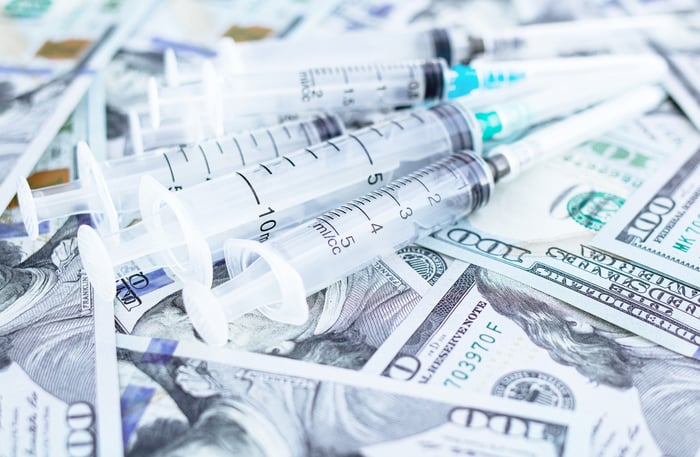This past week, the stock market celebrated the one-year anniversary of its bear market low of March 23, 2020. Since hitting this bottom, the tech-heavy Nasdaq Composite has more than doubled, while the broad-based S&P 500 has gained as much as 77%.
For many stocks, especially high-growth companies, the past year has been a roller-coaster ride of joy. But for shareholders in a small subset of predominantly healthcare-focused companies, it's been like hitting the winning lottery ticket.
Whereas the Nasdaq hasn't gone anywhere over the trailing three-month period (through March 24), five stocks have catapulted higher. If you had the foresight, luck, and stomach to invest $200,000 into any of these five companies three months ago, you'd be sitting on well over $1 million today.

Image source: Getty Images.
Cassava Sciences: $1.25 million
To start with, a $200,000 investment clinical-stage biotech stock Cassava Sciences (SAVA 0.24%) would have returned a cool 523% over three months. In dollar terms, we're talking about $200,000 growing into about $1.25 million.
The bullishness surrounding Cassava primarily has to do with its early February interim analysis data release for lead drug candidate simufilam. The experimental drug, which is targeted at Alzheimer's disease, demonstrated a 10% mean improvement from baseline to month six in cognition scores in an open-label study. It also improved dementia-related behavior, such as anxiety and agitation.
Cassava was able to capitalize on its monstrous stock run by issuing $200 million in stock through a registered direct offering. With roughly $280 million in available cash and an expected cash burn rate of $20 million to $25 million in 2021, the company is well funded for the foreseeable future.
However, investors should keep in mind that Cassava is still early in the testing process, and the late-stage clinical track record for Alzheimer's disease drugs is incredibly poor.

Image source: Getty Images.
GameStop: $1.55 million
I don't think anyone is surprised to see video game and accessories company GameStop (GME 1.50%) make this list. If you'd invested $200,000 in GameStop three months ago, it would be worth approximately $1.55 million today.
It's probably no secret that GameStop's core share price driver has been retail investors. Predominantly young and/or novice investors on Reddit's WallStreetBets chat room have been banding together for more than two months to buy shares and out-of-the-money call options on GameStop, with the purpose of effecting a short squeeze. Since GameStop had the highest short interest, relative to float, of any publicly traded company in mid-January, it made the company the perfect target for retail investors looking to put a hurt on short-sellers.
Unfortunately, investor euphoria can take a stock's share price only so far. Whether it's a few days, weeks, or months, operating results always come back into focus, just as they did this past week for GameStop.
Despite 191% e-commerce growth for the company last year, net sales plummeted 21% as GameStop closed 12% of its total stores in 2020. The fact remains that it waited too long to shift to a digital gaming model, and it's now scrambling to cut costs in an effort to backpedal into profitability.

Image source: Getty Images.
Zomedica: $1.64 million
Another healthcare stock that's been on fire since late December is veterinary-focused company Zomedica (ZOM 0.92%). A timely $200,000 investment into Zomedica three months ago would now be worth north of $1.6 million.
Zomedica's monster rally of more than 700% can be traced to three catalysts. First, the penny stock received press when Tiger King star Carole Baskin promoted the company in a YouTube video in mid-January. Second, Zomedica has benefited from the Reddit rally. And third, the company is readying to launch its point-of-care diagnostics systems for cats and dogs, known as Truforma, on March 30. This will allow Zomedica to transform into a revenue-producing company.
Although the final of the three catalysts is the only one that has any real bearing on Zomedica's valuation, it should be noted that uptake of Truforma by veterinary clinics won't happen overnight. According to Wall Street, Zomedica isn't expected to top $20 million in annual sales until 2023, yet it's sporting a jaw-dropping market cap of nearly $1.5 billion.
As a fan of companion animal-focused companies, I can appreciate the Truforma diagnostics system and Zomedica's operating model. But paying over 70 times projected sales for 2023 is a bit overboard.

Image source: Getty Images.
Bionano Genomics: $2.66 million
Genome analysis company Bionano Genomics (BNGO 4.44%) has also wowed investors. Over the past three months, Bionano has delivered a greater than 1,200% return to its shareholders. In dollar terms, we're talking about turning $200,000 into close to $2.7 million.
The good news for Bionano is that news-driven events, not retail investor whims, are what have driven its share price significantly higher. In particular, the company has been demonstrating what its optimal genome mapping (OGM) system, Saphyr, is capable of. In December, it appeared to handily outperform Pacific Biosciences' OGM technology in terms of sensitivity and price. Then, in early January, Bionano released a study that identified three autism spectrum disorder risk genes.
In simple terms, Saphyr might allow Bionano, or drug developers licensing the system, to identify risk genes for a variety of hard-to-treat diseases, and that could transform how drug developers approach the treatment process.
After raising roughly $335 million in fresh capital, Bionano doesn't have to worry about its working capital for a while. But it could be years before Saphyr is generating significant sales for the company. It's tough to see much additional upside here after such a monumental run.

Image source: Getty Images.
Ocugen: $5.05 million
The top-performing company over the past three months -- by a mile, might I add -- is clinical-stage biotech stock Ocugen (OCGN 0.81%). A $200,000 investment in Ocugen in late December would have risen by more than 2,400% to over $5 million, as of March 24.
Though Ocugen is known as a company focused on ophthalmic treatments, it's received the majority of its boost recently from its partnered development of a coronavirus disease 2019 (COVID-19) vaccine known as Covaxin. In early March, co-development partner Bharat Biotech announced an interim analysis vaccine efficacy of 81% from a 25,800-participant phase 3 trial in India. The hope at this point is the India-based trial will provide enough evidence to persuade the U.S. or Europe into granting Covaxin an emergency-use authorization (EUA).
However, a lot is riding on an eventual EUA. Even if the U.S. or Europe were to give Covaxin a green light, there are already a number of EUA-approved vaccines in these developed regions. By the time Covaxin enters the market, there might be only scraps left over, especially with a vaccine efficacy that trails the likes of Pfizer, Moderna, and vaccine hopeful Novavax.
It remains to be seen whether Covaxin and the company's experimental retinal therapies can support this monstrous 2,400%-plus gain.





